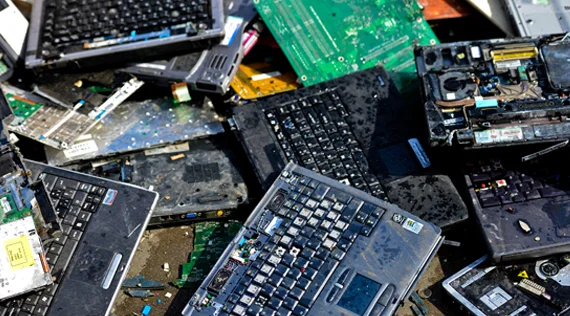
SEATTLE (Scrap Monster): From your car’s navigation display to the screen you are reading this on, luminescent polymers — a class of flexible materials that contain light-emitting molecules — are used in a variety of today’s electronics. Luminescent polymers stand out for their light-emitting capability, coupled with their remarkable flexibility and stretchability, showcasing vast potential across diverse fields of application.
However, once these electronics reach their end use, they are discarded, piling up in landfills or buried underground. Recycling this electronic waste is complex, requiring expensive and energy-inefficient processes. Although there is an economic incentive to recycle the key semiconducting materials — in this case, luminescent polymers — there has been no method to achieve this due to the challenge of designing those materials at the molecular level.
Overcoming this challenge was the motivation behind the newest Nature Sustainability publication led by researchers at the U.S. Department of Energy’s (DOE) Argonne National Laboratory, along with collaborators at the University of Chicago, Purdue University and Yale University. The team developed a strategy to design luminescent polymers with high light-emitting efficiencies from the start that are both biodegradable and recyclable. They do so by incorporating a chemical called tert-butyl ester into the luminescent polymers, which can break down when exposed to heat or mild acid.
In short, this chemical enables the recycling of the material while maintaining high light-emitting functions.
The team then used a device to test the material’s external quantum efficiency, an indicator of light source performance. It scored an impressive 15.1% in electroluminescence, a tenfold increase from the existing degradable luminescent polymers.
At the end of life, this new polymer can be degraded under either mild acidic conditions (near the pH of stomach acid) or relatively low heat treatment (> 410 F). The resulting materials can be isolated and remade into new materials for future applications.
The team aims to make future electronics more sustainable (easier to degrade or recycle) and not just design for current function. They also want to expand the usability of these products into other fields.
Next steps for scaling the technology include moving it from the lab to electronics such as cell phones and computer screens with continued testing.
The team noted this is only a first step in the process, but with electronic waste, every step counts. They hope that more attention will be paid to designing electronics with sustainability in mind, especially since this depolymerization proof of concept was so successful.
Courtesy: www.waste360.com



| Copper Scrap View All | |
| Alternator | 0.39 (0) |
| #1 Copper Bare Bright | 4.55 (0.05) |
| Aluminum Scrap View All | |
| 356 Aluminum Wheels (Clean) | 0.83 (0) |
| 6061 Extrusions | 0.73 (0) |
| Steel Scrap View All | |
| #1 Bundle | 385.00 (0) |
| #1 Busheling | 405.00 (0) |
| Electronics Scrap View All | |